Intro
Discover 7 effective ways to remove tonsilloliths, including natural remedies, homemade treatments, and medical procedures, to alleviate tonsil stone symptoms and prevent recurrence, promoting overall oral health and wellness.
Tonsilloliths, also known as tonsil stones, are small, hard deposits that form on the surface of the tonsils. They are usually white or yellowish in color and can cause bad breath, sore throats, and difficulty swallowing. Tonsilloliths are often a sign of poor oral hygiene and can be a source of discomfort and embarrassment for those who suffer from them. In this article, we will explore the importance of removing tonsilloliths and the various methods that can be used to do so.
Tonsilloliths can be a recurring problem for some people, and if left untreated, they can lead to more serious health issues. For example, tonsilloliths can cause chronic bad breath, which can affect a person's self-confidence and social interactions. Additionally, tonsilloliths can increase the risk of tonsillitis, a painful inflammation of the tonsils that can lead to fever, sore throat, and difficulty swallowing. Therefore, it is essential to remove tonsilloliths as soon as possible to prevent these complications.
The formation of tonsilloliths is often caused by the accumulation of food particles, mucus, and other debris in the tonsil crypts. When these particles are not properly removed, they can harden and form stones. Poor oral hygiene, such as infrequent brushing and flossing, can contribute to the formation of tonsilloliths. Other factors, such as large tonsils, poor diet, and certain medical conditions, can also increase the risk of developing tonsilloliths. By understanding the causes of tonsilloliths, individuals can take steps to prevent their formation and reduce the risk of complications.
Understanding Tonsilloliths
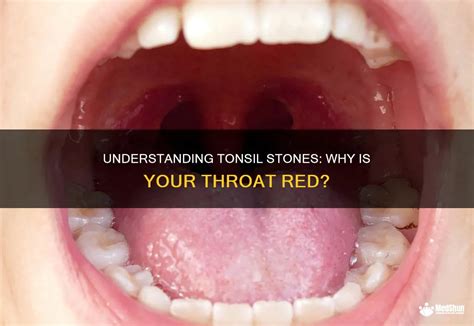
Methods for Removing Tonsilloliths
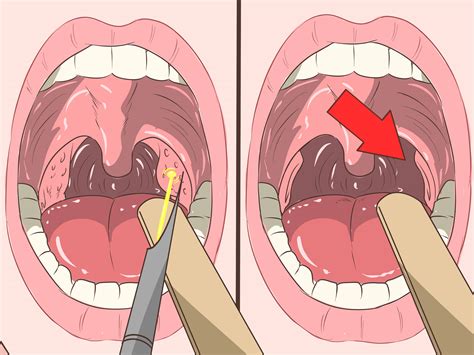
- Gargling with salt water to help loosen and dislodge the stones
- Using a waterpik to flush out the tonsil crypts and remove debris
- Brushing the tonsils with a soft-bristled toothbrush to remove any visible stones
- Using a cotton swab to gently remove stones from the surface of the tonsils
- Sucking on a lemon or other sour candy to help stimulate saliva production and neutralize acid
Home Remedies for Tonsilloliths
There are also several home remedies that can be used to help remove tonsilloliths. These include:- Gargling with apple cider vinegar to help break down and dissolve the stones
- Using a neti pot to rinse the nasal passages and sinuses
- Drinking plenty of water to help flush out the body and prevent dehydration
- Eating a healthy diet rich in fruits, vegetables, and whole grains to help boost the immune system
- Avoiding dairy products and other foods that can trigger the formation of stones
Tonsilloliths Removal Techniques
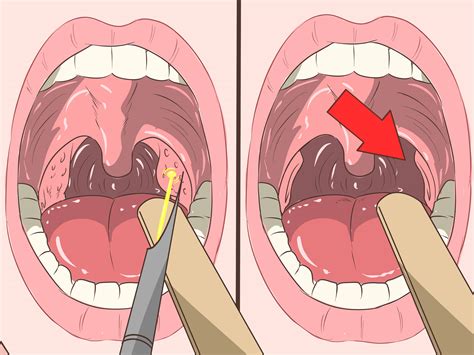
- Laser tonsil cryptolysis, a procedure that uses a laser to vaporize the stones and reduce the size of the tonsils
- Coblation cryptolysis, a procedure that uses a special device to remove the stones and reduce inflammation
- Tonsillectomy, a surgical procedure that involves removing the tonsils entirely
Risks and Complications of Tonsilloliths Removal
While removing tonsilloliths can be an effective way to alleviate symptoms and prevent complications, there are also some risks and complications to consider. These include:- Bleeding or infection after surgery
- Damage to the surrounding tissues or nerves
- Recurrence of the stones
- Changes in speech or swallowing patterns
Preventing Tonsilloliths
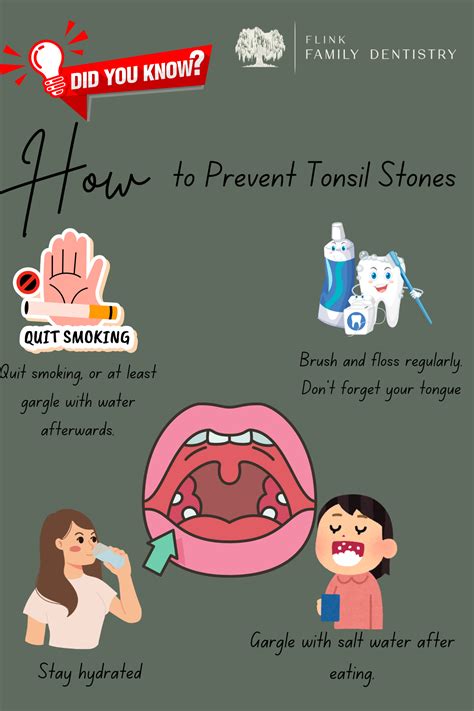
- Brushing the teeth and tongue at least twice a day
- Flossing once a day to remove food particles and debris
- Rinsing the mouth with salt water or mouthwash to help kill bacteria
- Avoiding tobacco and other irritants that can dry out the mouth and increase the risk of stones
- Eating a healthy diet rich in fruits, vegetables, and whole grains to help boost the immune system
Tonsilloliths and Oral Health
Tonsilloliths are often a sign of poor oral health, and removing them can be an important step in maintaining good oral hygiene. By practicing good oral hygiene and taking steps to prevent tonsilloliths, individuals can reduce their risk of complications and improve their overall health.Tonsilloliths Treatment Options
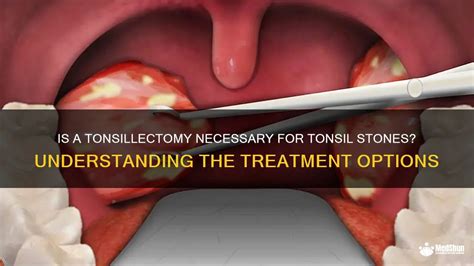
- Antibiotics to help kill bacteria and reduce inflammation
- Pain relievers to help alleviate discomfort and pain
- Anti-inflammatory medications to help reduce swelling and inflammation
- Surgery to remove the stones or tonsils
Tonsilloliths and Breathing Problems
Tonsilloliths can also cause breathing problems, such as sleep apnea or difficulty breathing through the nose. By removing the stones and practicing good oral hygiene, individuals can help improve their breathing and reduce their risk of complications.Tonsilloliths and Nutrition
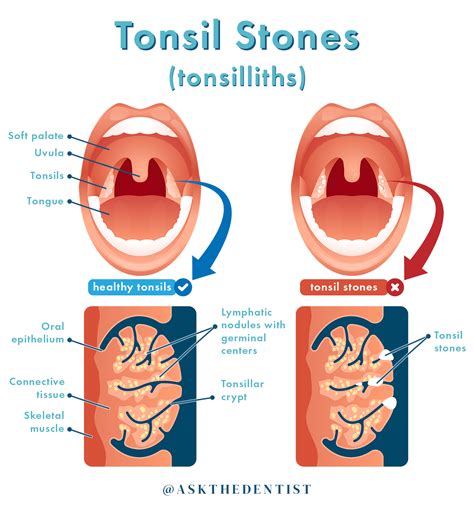
Tonsilloliths and Lifestyle Changes
In addition to dietary changes, there are several lifestyle changes that can help prevent tonsilloliths. These include:- Quitting smoking and avoiding tobacco products
- Reducing stress and anxiety through relaxation techniques such as meditation or yoga
- Getting plenty of sleep and practicing good sleep hygiene
- Avoiding irritants such as pollution and chemicals
What are tonsilloliths and how are they formed?
+Tonsilloliths are small, hard deposits that form on the surface of the tonsils. They are usually white or yellowish in color and can cause bad breath, sore throats, and difficulty swallowing. Tonsilloliths are formed when food particles, mucus, and other debris accumulate in the tonsil crypts and harden.
What are the symptoms of tonsilloliths?
+The symptoms of tonsilloliths can include bad breath, sore throats, difficulty swallowing, and a sensation of something being stuck in the throat. In some cases, tonsilloliths can also cause fever, headache, and fatigue.
How can tonsilloliths be removed?
+Tonsilloliths can be removed through a variety of methods, including gargling with salt water, using a waterpik, brushing the tonsils with a soft-bristled toothbrush, and sucking on a lemon or other sour candy. In some cases, surgery may be necessary to remove the stones or tonsils.
Can tonsilloliths be prevented?
+Yes, tonsilloliths can be prevented by practicing good oral hygiene, eating a healthy diet, and avoiding irritants such as tobacco and pollution. Regular dental check-ups and cleanings can also help to prevent tonsilloliths.
What are the risks and complications of tonsilloliths removal?
+The risks and complications of tonsilloliths removal can include bleeding or infection after surgery, damage to the surrounding tissues or nerves, and changes in speech or swallowing patterns. In some cases, the stones may recur after removal.
In summary, tonsilloliths are a common problem that can cause bad breath, sore throats, and difficulty swallowing. By understanding the causes and symptoms of tonsilloliths, individuals can take steps to prevent their formation and reduce the risk of complications. Removing tonsilloliths can be an effective way to alleviate symptoms and improve overall health. We invite you to share your thoughts and experiences with tonsilloliths in the comments section below. If you found this article helpful, please share it with others who may be struggling with tonsilloliths. By working together, we can help to raise awareness and promote better oral health for everyone.
